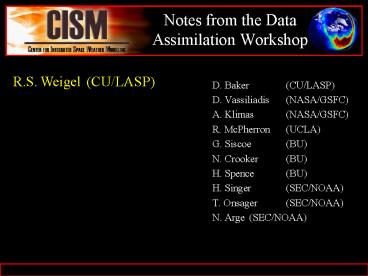Notes from the Data Assimilation Workshop PowerPoint PPT Presentation
Title: Notes from the Data Assimilation Workshop
1
Notes from the Data Assimilation Workshop
R.S. Weigel (CU/LASP)
- D. Baker (CU/LASP)
- D. Vassiliadis (NASA/GSFC)
- A. Klimas (NASA/GSFC)
- R. McPherron (UCLA)
- G. Siscoe (BU)
- N. Crooker (BU)
- H. Spence (BU)
- H. Singer (SEC/NOAA)
- T. Onsager (SEC/NOAA)
- N. Arge (SEC/NOAA)
Knowledge Transfer and Empirical Modeling Team
2
Data Assimilation Workshop Notes
- CU/LASP held a data assimilation workshop after
Space Weather Week - Copies of the talks are available at
http//lasp.colorado.edu/cism/Data_Assimilation
- Why and What is Data Assimilation?
- What Data Assimilation is not
- Key Challenges in Data Assimilation
- Key Challenges with respect to magnetospheric DA
- How magnetospheric DA differs from meteorological
DA
3
Lessons LearnedWhy and What is DA?
- Purpose of data assimilation is to combine
measurements and models to produce best estimate
of current and future conditions. - Kalman filter is most often used as a method for
data assimilation. It became popular because it
is a recursive solution to the optimal estimator
problem. (Only last time step of information
needs to be stored.) - Full implementation of Kalman is usually not
possible. There is a growing field in the study
alternatives.
- Data assimilation does not require a
physics-based model. - AD ? DA (The Assimilation of Data is not
necessarily Data Assimilation)
4
Challenges in DA
- Analyzed field does not match a realizable model
state - Non-uniform and sparse measurements
- Observed variables do not match variables
predicted by the model - Observing systems are diverse and subject to
error, sometimes poorly known.
5
Challenges For Magnetospheric DA
- Very sparse measurements
- Diverse set of both forward and inverse models
that are highly specialized and are expert in
different areas.
- How to combine forward models (MHD, particle
pushing) with inverse models (empirical,
stochastic). - How to integrate data with these models
6
Differences between SW and Ordinary Weather
- SW is usually more concerned with unlikely events
- Magnetosphere is strongly forced
PowerShow.com is a leading presentation sharing website. It has millions of presentations already uploaded and available with 1,000s more being uploaded by its users every day. Whatever your area of interest, here you’ll be able to find and view presentations you’ll love and possibly download. And, best of all, it is completely free and easy to use.
You might even have a presentation you’d like to share with others. If so, just upload it to PowerShow.com. We’ll convert it to an HTML5 slideshow that includes all the media types you’ve already added: audio, video, music, pictures, animations and transition effects. Then you can share it with your target audience as well as PowerShow.com’s millions of monthly visitors. And, again, it’s all free.
About the Developers
PowerShow.com is brought to you by CrystalGraphics, the award-winning developer and market-leading publisher of rich-media enhancement products for presentations. Our product offerings include millions of PowerPoint templates, diagrams, animated 3D characters and more.

